How to Build a Multibody in Simulink
This example highlights key concepts and recommended steps for building a mechanical model using Simscape™ Multibody™. A simple design problem has been chosen to serve this purpose. The following section describes the design problem and subsequent sections discuss how to solve it.
Problem Description
The following figure shows a mechanism which functions as an aiming system.

The problem is simplified to aiming within the plane of the mechanism. The figure shows the schematic sketch of the mechanism and only captures the essentials of how the mechanism operates (which is usually the case during the early stages of a design process). The link C can slide on the link A. A motor applies torque τ at the revolute joint Ri and the task is to track a particular trajectory of the revolute angle β.
Building the Model
A key principle to follow while building models is to begin with a simple approximation to get the basic mechanism working. In subsequent iterations add complexity to the model. The recommended model building process in Simscape Multibody can be broken down into the following steps:
Identify the rigid bodies in the mechanism.
Identify how the rigid bodies are connected to each other (joints, constraints etc).
Consider each rigid body in isolation. Build a simple approximation of the rigid body, and define the frames rigidly attached to it.
Assemble the rigid bodies using joints and/or constraints. Utilize the Variable Viewer to identify any issues with the model assembly.
Utilize the Multibody Explorer to identify and fix other issues with the model.
Set Joint Targets to guide assembly to desired configuration.
Hook up inputs and outputs to the mechanism. Test and Validate the model. If applicable, attach a controller and test the model.
Add detail to the individual rigid bodies to make the model a more accurate representation of the actual mechanism.
The following sections describe these steps in more detail. You can see all the model files, which are described in the following sections, in the MATLAB® Current Folder Browser after opening this example.
Identifying Rigid Bodies and Joints
The mechanism has four rigid bodies
Rigid Body A (orange)
Rigid Body B (blue)
Rigid Body C (green)
Rigid Body D (gray)
The mechanism has the following joints
Rigid bodies A and D are connected via a revolute joint Ro.
Rigid bodies A and C are connected via a prismatic joint Pg.
Rigid bodies C and B are connected via a revolute joint Rg.
Rigid bodies B and D are connected via a revolute joint Ri.
In addition, the rigid body D is rigidly connected to the world frame W since it is motionless.
Defining the Rigid Bodies and Their Interface
You define a rigid body by specifying its shape, mass properties and interface with other parts. Each rigid body is identified and defined in isolation. In the above example, the mechanism is composed of four rigid bodies: A, B, C and D.
The rigid body A is shown in isolation below.

First, define the shape of the rigid body A in Simscape Multibody. Once the shape of the object is defined and its density is specified, Simscape Multibody can compute the inertia automatically. Instead of defining the fairly complicated shape shown above, as a first approximation, you can define the shape of the rigid body as a simple cylinder with a length equal to that of the original part.

Once you have defined the shape (first approximation) of the rigid body A, specify its density. Simscape Multibody now has enough information to compute the inertial properties required for dynamic simulation. In Simscape Multibody, you define a simply shaped rigid body using the Solid block.

The Solid block lets you define simple solids with fixed parameterizations. These include: bricks, cylinders, polygonal extrusions, regular prisms, spheres, ellipsoids, etc. You define each parameterized solid with respect to a reference frame. The diagram below shows the reference frames for some of the parameterized solids. The Solid block exposes this reference frame as a frame port labeled R on the block.

The interface of a rigid body is established by defining frames attached to the rigid body. A rigid body is connected to other parts of the mechanism via the rigidly attached frames. In Simscape Multibody, joints establish a time-varying relationship between two frames. For instance, the Revolute Joint establishes the relationship that the Z-axes of the attached frames are parallel and the origins of the frames are coincident. The Prismatic Joint establishes the relationship that the Z-axes of the attached frames are collinear and the X and Y axes are always parallel. Note that the frames themselves are defined independently of the joint; the joint only establishes a relationship between the already existing frames. Note also that the Z-axis is the axis of rotation in the case of the revolute joint and is the axis of sliding in the case of the prismatic joint. This information is essential when we define the interface of a rigid body by defining the frames rigidly attached to it.
In this example, the rigid body A has a cylindrical hole at one end that fits onto a peg so that A can rotate about the axis of the cylindrical hole. This suggests that a frame should be defined at the hole center with its Z-axis aligned with the axis of the hole (the axis of rotation). This frame is labeled as above. The choice of orientation of the X and Y axes of partly determines the zero configuration of the joint to which would be connected (see discussion on Zero Configuration below). A also acts as the shaft on which part C slides. This suggests that a frame should be defined at the center of A (an arbitrarily selected position) with its Z-axis aligned along the length of A (along the direction of sliding). This frame is labeled as above. The frames and define the interface for the rigid body A. The model HowToBuildAMultibodyInSimulinkBodyAApproximate shows how the Solid and Rigid Transform blocks have been used to define the shape, inertia and interface of the rigid body A. The Body A Ref is a Reference Frame block. This block is not required but serves as a modeling convenience that fixes a certain frame as the frame to which other frames are referenced to. The frames and are defined with respect to the frame to which the Body A Ref block is connected. For a more complicated network of blocks defining a rigid body, such a reference frame serves as a starting point for defining the positions and orientations of all other frames.

Run the model HowToBuildAMultibodyInSimulinkBodyAApproximate to visualize the model in the Multibody Explorer.
Consider the rigid body B. The shape of the rigid body can again be approximated with a simple cylinder. The rigid body has cylindrical holes at both ends that fit onto pegs. The rigid body B can rotate about either hole axis. This suggests that two frames should be defined: one at each hole center with its Z-axis aligned with the axis of the hole.
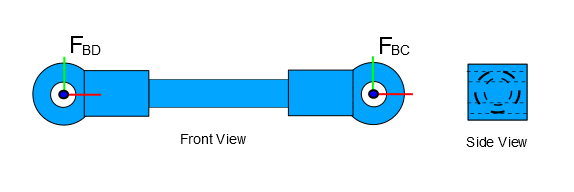
The model HowToBuildAMultibodyInSimulinkBodyBApproximate shows how the Solid and Rigid Transform blocks have been used to define the shape, inertia and interface of the rigid body B.

Run the model HowToBuildAMultibodyInSimulinkBodyBApproximate to visualize the model in the Multibody Explorer. A similar approach can be taken for building a first approximation of the rigid body D.
Consider the rigid body C.

This rigid body has a cylindrical hole that slides on a peg. It also has a peg about which another body can rotate. This suggests the need to define two frames: one at the center of the hole with its Z-axis along the axis of the hole, and the other at the center of the peg with its Z-axis along the axis of the peg. These are marked as and above.
The shape of the rigid body C can be approximated with a simple cuboid. In the first approximation of the rigid body, the offset between the origins of frames and can also be made zero. This results in the simplified representation of rigid body as shown below.
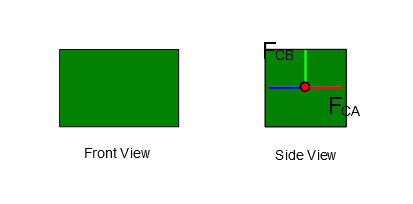
The model HowToBuildAMultibodyInSimulinkBodyCApproximate shows how the Solid and Rigid Transform blocks have been used to define the shape, inertia and interface of the rigid body C.
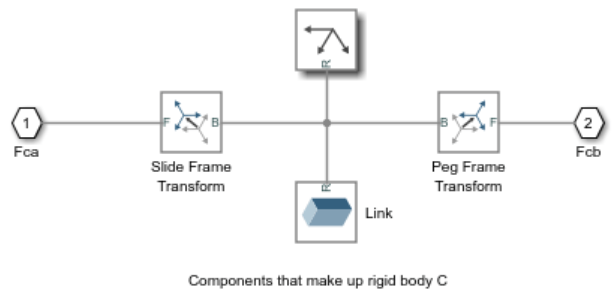
Assembling the Individual Bodies Using Joints
All the individual bodies were built in isolation. The process of assembly involves establishing relationships (using joints) between the frames attached to the rigid bodies. The following joints establish all of the necessary relationships between the frames to assemble the mechanism.
A Revolute Joint between the frames and
A Prismatic Joint between the frames and
A Revolute Joint between the frames and
A Revolute Joint between the frames and
The effort that went into carefully defining the interfaces of all of the rigid bodies (i.e. the frames attached to them) makes it very easy to complete the mechanism by simply adding joints between the appropriate frames. There is no need to customize the joints to achieve a default assembly of the mechanism. The resulting assembly may or may not be in the desired configuration since the mechanism can be assembled into multiple configurations. The model HowToBuildAMultibodyInSimulinkAssemblyWithError shows the assembled mechanism.
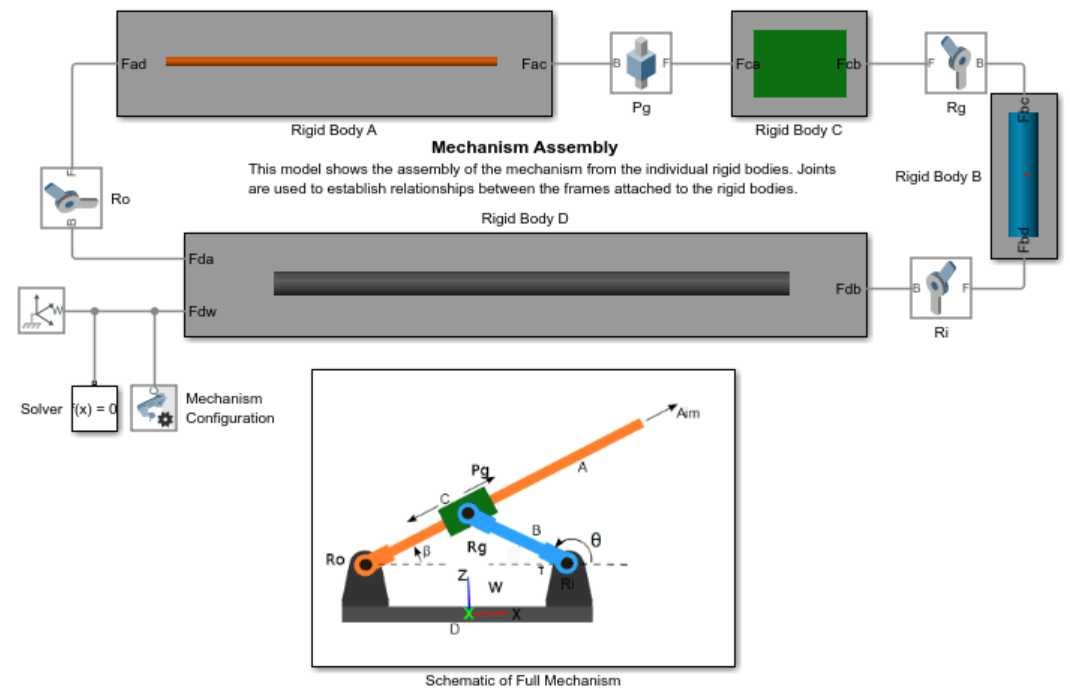
Using the Variable Viewer to Identify Problems
In the model, an intentional mistake has been made in the definition of the frame attached to rigid body C. This causes the assembly to fail. The figure below shows the desired and actual orientations of the frame .
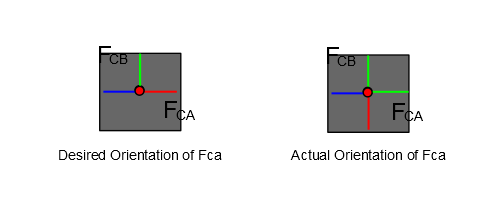
The orientation of has to be corrected by a rotation of 90 deg about the Z-axis. Update the model (Ctrl-D) HowToBuildAMultibodyInSimulinkAssemblyWithError to visualize the mechanism. An error is reported indicating that the assembly failed. In the Multibody Explorer, select Variable Viewer from the Diagnostics section. The Variable Viewer shows that the joint Pg has failed to assemble. This indicates that there might be an error in the specification of the frames attached to the joint Pg. In this example it is in fact true that an error was made in the specification of the frame .
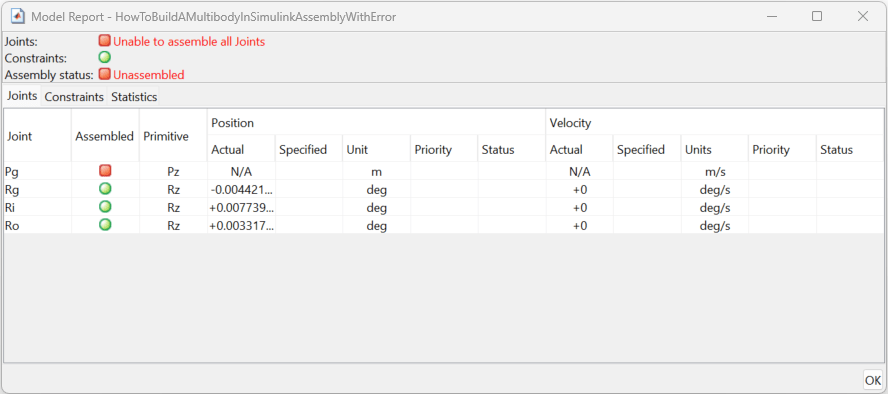
Changing the parameters of the rigid transform HowToBuildAMultibodyInSimulinkAssemblyWithError/Rigid Body C/Slide Frame Transform as shown below fixes the problem allows the assembly to succeed.


Zero Configuration of Joints
The zero configuration of a joint is defined as the relative position and orientation between the base and follower frames when all of the joint angles are zero. For almost all of the joints in Simscape Multibody, the base and follower frames are identical in the zero configuration: their origins are coincident, and their axes are aligned. One defines the relative position and orientation between two bodies connected by a joint when the joint angles are zero by adjusting the positions and orientations of the base and follower frames on their respective bodies.
Consider, for example, the rigid bodies B and C and the joint Rg connecting them. The frames and are the base and follower frames of the joint Rg. The figure below shows how different choices of orientations for the frame attached to rigid body C result in different assembled configurations when the joint angle is zero. The choice of orientation of the frames must be made with the desired zero configuration in mind.
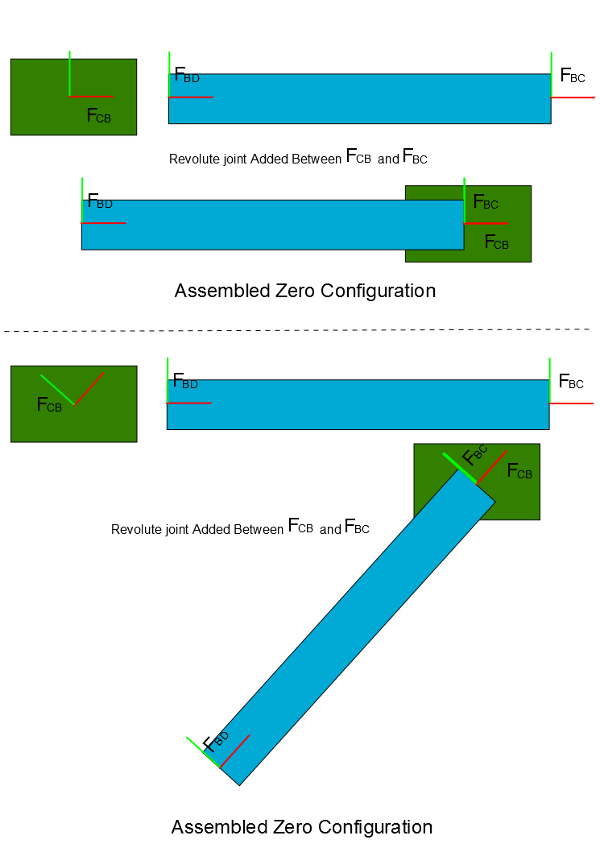
In the aiming mechanism, the choice of frame orientations leads to a default assembled configuration in which the central axes of all of the bodies lie along the same line.
Guiding Assembly Using Joint Targets
Update the model (Ctrl-D) HowToBuildAMultibodyInSimulinkAssemblyWithError (after the errors have been fixed) to visualize the assembled mechanism. It can be seen that all of the bodies are collapsed onto a common line; this is the default assembly configuration. In this configuration, all of the revolute joint angles are zero. Thus, the base and follower frames of each revolute joint are coincident and aligned with each other; the corresponding frame pairs are: and , and and and . In contrast, the frame is translated from frame , thus the joint Pg is not in its zero state. Open the Variable Viewer to see the values of the joint positions in this assembled configuration. This is not a desirable assembly configuration.

The configuration depicted in the schematic diagram of the mechanism is the desired initial assembly configuration. From the schematic diagram we can see that in the initial configuration the angle is about 35 deg. The assembly algorithm can be guided by specifying joint position and velocity targets. In this example, the position target for the joint Ro can be set to guide assembly into the desired initial configuration (see figure below). The target priority has been set as High. Since this is the only target in the model, Simscape Multibody is able to achieve it exactly.
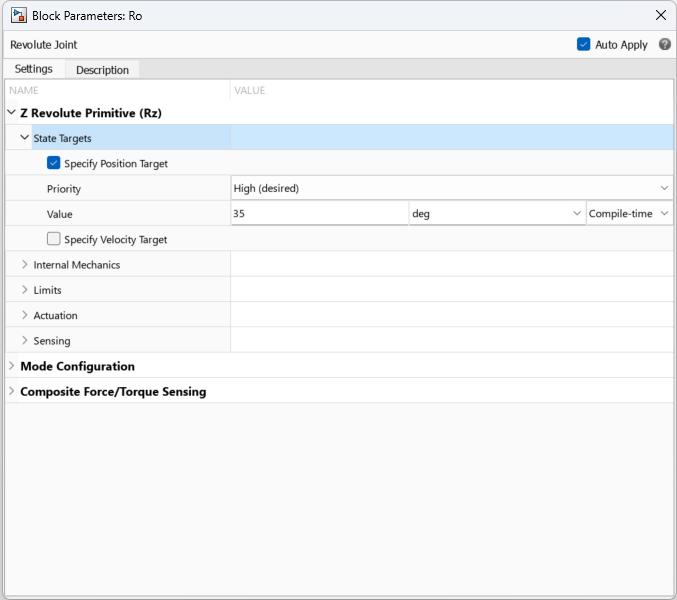
Update the model (Ctrl-D) to update the visualization with the changes. The assembly is closer to the configuration in the schematic diagram. Check the Variable Viewer to see that the joint target for Ro has been met exactly.
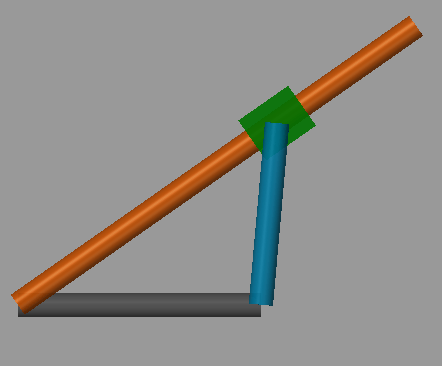
Unfortunately, the assembled configuration is not the intended one because the rigid body B is not aligned as indicated in the schematic diagram. Attempting to specify the joint angles of both and exactly is an over-specification for this one degree-of-freedom mechanism. This is not prohibited, but if there is a conflict, neither target may be met. Moreover, the desired angle of joint Ri is not even known exactly.
In this situation, a convenient approach is to leave the high-priority target of 35 deg on Ro but to specify the angle of Ri through a low-priority position target. The latter provides an approximate value, or hint, for the desired joint angle. In this case, it is obvious that the angle should be obtuse; 150 deg is a rough estimate of its desired value. This target is set for joint Ri with a priority of Low.

The assembled configuration after setting the new target is shown below.
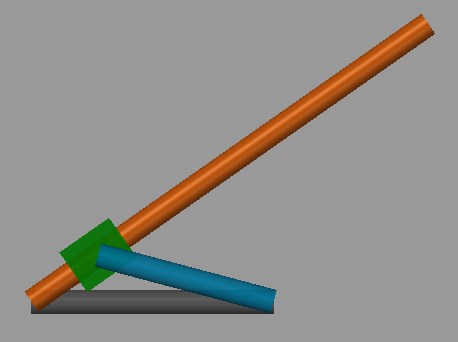
Simulate the model (Ctrl-T) to view the motion of the mechanism under gravity.
Setting up the Model for Control Design
In this example, the goal is to make the angle track a desired trajectory by applying a torque at the joint Ri. The joint Ri will be torque actuated and the joint angle and its derivative (angular velocity) will be sensed from the joint Ro. The entire mechanism can be enclosed within a subsystem that takes a torque input and outputs the angle and angular velocity . This subsystem is the canonical Plant in Control Design parlance. The model HowToBuildAMultibodyInSimulinkPlant shows the mechanism setup for control design.
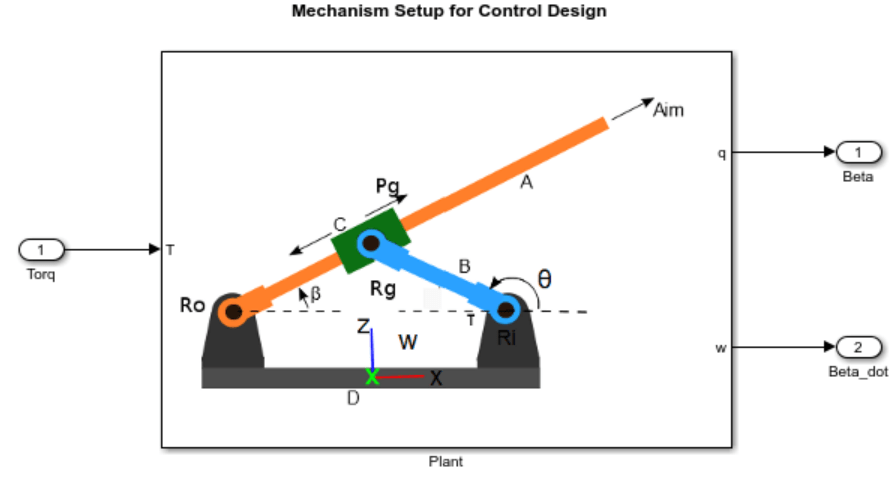
The details of the Plant subsystem is shown below.
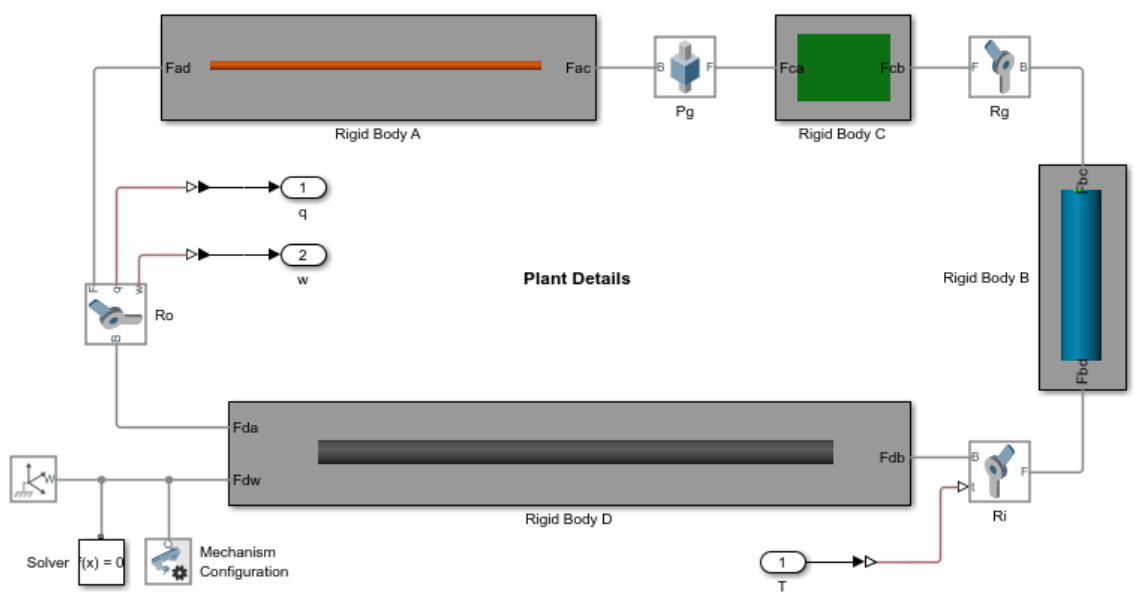
The model HowToBuildAMultibodyInSimulinkVersion1 shows the Plant hooked up to a Controller. The tracking performance of the controller can be viewed in the scope. A simple PD controller has been designed to achieve tracking.
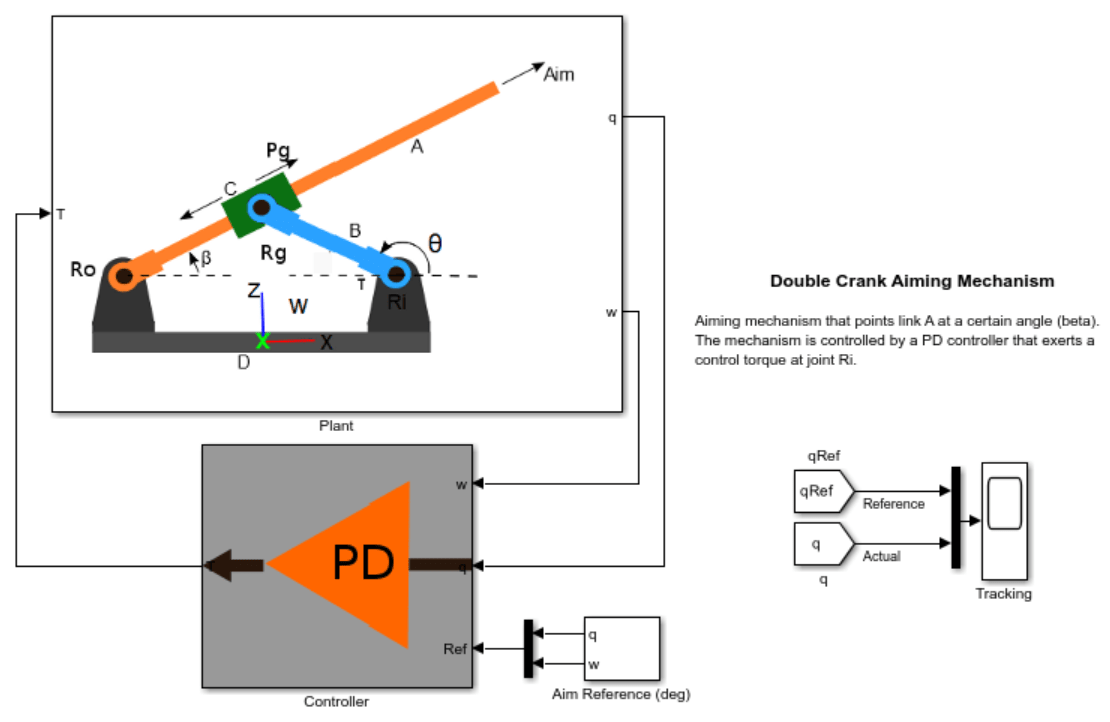
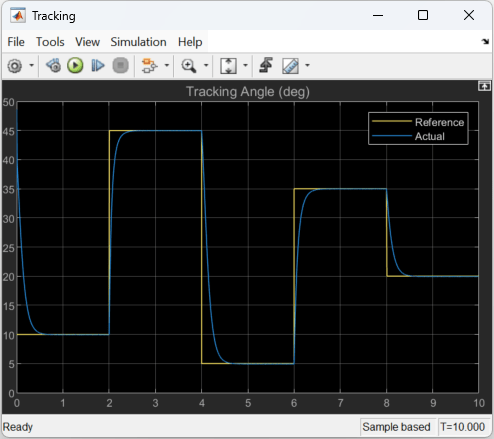
Adding Detail to the Rigid Bodies
Now that the basic model is working, the next step is to add detail to make the model more realistic and accurate. Perhaps the first version of the model was created when detailed information about the geometry of the rigid bodies was not yet available. Having carefully established the interfaces of the rigid bodies, it is fairly easy to add detail to each of the rigid bodies without affecting/changing the rest of the model.
As an example, consider adding detail to the rigid body A while keeping its interface unchanged. The figure below shows rigid body A as a composition of simpler bodies. The interface exposed by rigid body A is still the pair of frames and . Their positions and orientations remain unchanged. The frames , , and are internal to the rigid body and should be created to assemble the individual pieces of the rigid body into a whole. The model HowToBuildAMultibodyInSimulinkBodyAComplex shows the construction of the complex version of the rigid body A.
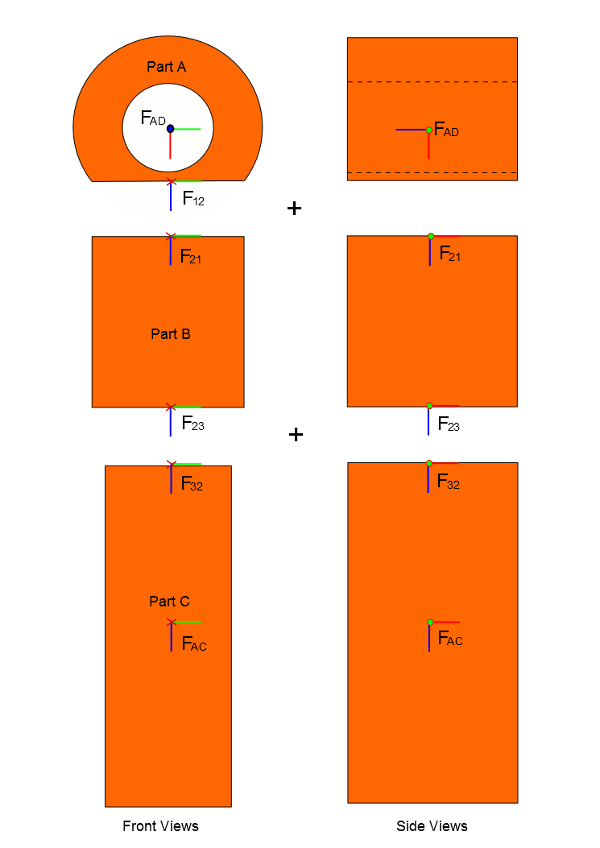
The second version model HowToBuildAMultibodyInSimulinkVersion2 was obtained from HowToBuildAMultibodyInSimulinkVersion1 by just replacing the subsystem corresponding to rigid body A with the complex version from HowToBuildAMultibodyInSimulinkBodyAComplex. Because the interface remained constant, it was a simple operation of replacing the blocks. Simulate the model HowToBuildAMultibodyInSimulinkVersion2 to visualize the modified mechanism.
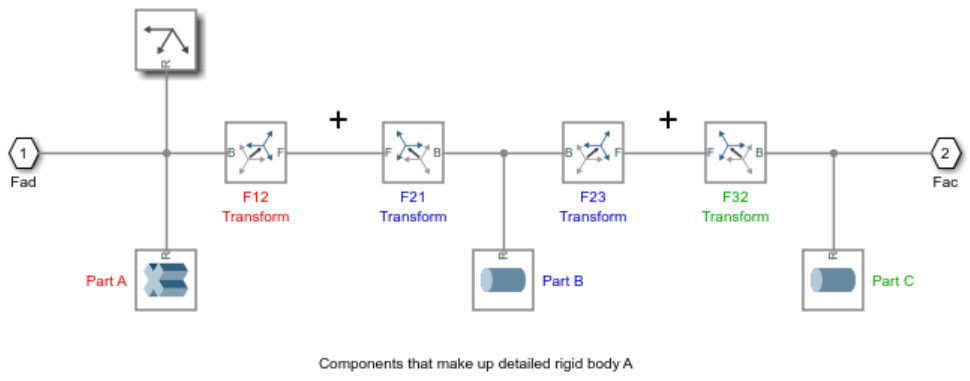
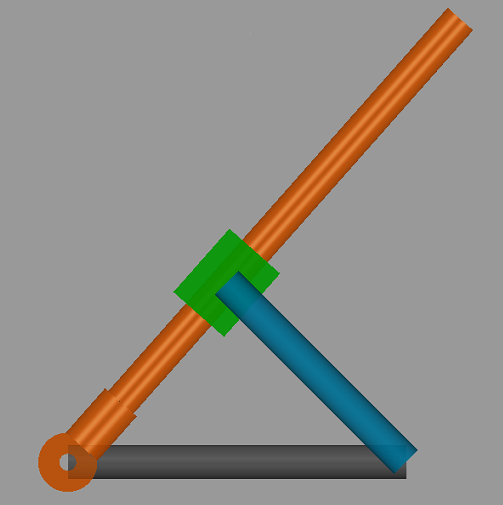
The tracking performance is similar because the controller is sufficiently robust to handle the slight differences in inertia between the simple and detailed version of rigid body A. Following a similar process, we can also add detail to the other parts. Different versions of each rigid body with varying levels of detail can be maintained in a library, and the model can be tested with these various alternatives. Configurable Subsystems would be useful here.
Summary
In summary, we took the following steps:
Started with a schematic diagram of the mechanism and identified the rigid bodies and joints in the mechanism.
Built a first approximation of each rigid body in isolation
Assembled the rigid bodies together using joints to achieve the first version of the assembled mechanism.
Used the Variable Viewer tool to identify problems with the assembly
Used Joint Position Targets to guide the assembly into a desirable configuration.
Added a simple controller to the model to achieve target angle tracking.
Once a full first version of the model was complete, added details to one of the rigid bodies without changing the interface of the rigid body. Details could be added to other rigid bodies as well.
This method of starting simply and adding complexity in subsequent iterations is recommended when building models in Simscape Multibody.